Unfortunately, nothing lasts forever.
Forklifts are no exception.
They’re machines built to work. And because they’re mechanical, it’s a matter of WHEN, not IF, parts break down.
Amid the many components of a truck, you may have an enclosed operator cab.
Some argue it’s not the most important part of a truck. But, it’s where your operator spends most of his/her time.
And if a replacement part is too difficult to acquire, it soon becomes a major headache that can affect operator morale and productivity.
After more than 50 years of designing and building nothing but operator cabs, here are the top five replacement parts we get asked about most often:
1-Pneumatic Cylinders
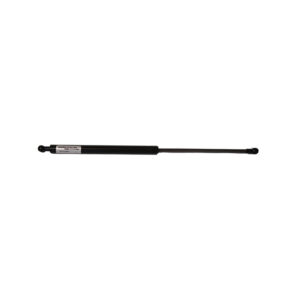 Also commonly known as Gas springs. Gas shocks. Door shocks. Shlack shlocks.
Also commonly known as Gas springs. Gas shocks. Door shocks. Shlack shlocks.
Ok, we made that last one up.
Nobody calls them that.
Not even Dr. Seuss.
What do pneumatic cylinders do? Much like how they’re used for heavy objects on your automobile (your hood, your trunk/hatchback), they provide output force and motion damping to safely open and close it.
In simple terms, they prevent the cab door from slamming on your arms or legs when getting in and out.
Under normal operating conditions, cylinders should last for years of service. Eventually though, usually between 2-7 years, they lose pressure.
Predicting how long they’ll last isn’t an exact science. It depends on the number of cycles (opens/closes), temperature, vibration, and other factors.
Otherwise, pneumatic cylinders need virtually no maintenance. They’re a long-lasting alternative to coil or leaf springs, and are most often found on forklift cabs in 30lb, 60lb, or 90lb options.
EXPERT TIP – keep your piston rods clean, and don’t open/cut/bend the cylinders. They’re under extremely high pressure. They last longest when used in operating temperatures between –35 degrees Celsius and 80 degrees Celsius.
2-Wiper Blades
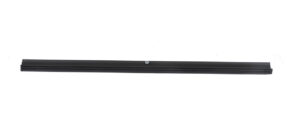 This one shouldn’t come as a surprise.
This one shouldn’t come as a surprise.
It’s recommended that you change your automotive wiper blades every 6 to 12 months.
Why would you expect your forklift wiper blades to last any longer?
Wiper blades are made of rubber, which is degradable, and that means its effectiveness will wane over time (even in optimal conditions).
Considering forklifts are often used in dirty environments, they attract more muck to wipe off the windshield. More muck means more abrasion on the blades, which means faster wear and tear.
And, forklifts are shared equipment. They tend to have many operators (who don’t always share the same sense of ownership in properly maintaining company equipment). After all, it’s not their personal property.
Depending on your cab design, wiper blade lengths can vary from 14” to 24”, and can be flat or curved.
EXPERT TIP – Clean your wiper blades regularly, wiping them down with warm soapy water. Removing excess grime helps reduce streaking and annoying squeaking noises.
3-Wiper Motors
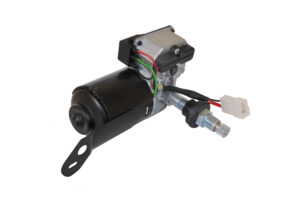 Related to the wiper blade is its cousin, the wiper motor.
Related to the wiper blade is its cousin, the wiper motor.
Not a Clark Griswold “Cousin Eddie” type. Someone a little more competent.
The wiper motor and wiper blade complement each other. They work in tandem, considering one can’t do much without the other.
Wiper motors are intended to last for years, and with proper care they do.
But heat and moisture exposure take a toll, and your forklift wiper motor will eventually need replacing.
Again, depending on your truck model, wiper motors are typically available as 1-speed or 2-speed options, and 12V/24V/40V to match the engine.
EXPERT TIP – Don’t operate your wipers dry. The added friction puts significantly more stress on the motor, reducing its lifespan.
4-Door Straps
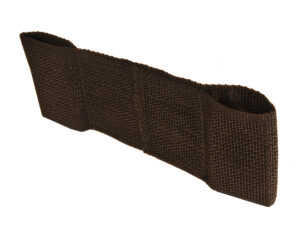 Maybe you weren’t expecting this one.
Maybe you weren’t expecting this one.
Maybe you don’t know what it is.
Maybe you were preoccupied with your shlack shlocks?
Ok, stop it.
The door strap is a limiting device that, you guessed it, prevents the door from opening too wide.
When the door opens too wide, it can damage things (or get damaged in the process). If the door gets damaged, it may impair the seal. If the door doesn’t seal properly, your operator gets cold and distracted.
That’s when bad stuff starts happening.
These fabric straps are most common in 8” and 12” lengths, again depending on your cab design.
EXPERT TIP – Make sure your door strap engages the door BEFORE the pneumatic cylinder does. It will extend the life of your pneumatic cylinder (and a door strap replacement is one-third the cost of a pneumatic cylinder).
5-LH Door Handle
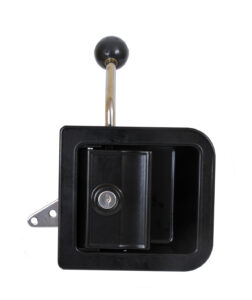 Unlike an automobile, you can climb into the driver seat of a forklift from the left side or the right side.
Unlike an automobile, you can climb into the driver seat of a forklift from the left side or the right side.
In North America, the overwhelming majority of people prefer the left side.
As a result, the left-hand door of the cab gets far more use. And abuse. And needs replacing sooner.
Sometimes it’s the outside handle. Sometimes it’s the inner rotary latch. Or the striker bolt. There are many moving pieces.
Paddle handles are a common feature if the cab design accommodates them because they sit flush against the door. If the handles extend beyond the width of your truck, it can become a nuisance (particularly in confined spaces).
EXPERT TIP – Ensure your door handles come equipped with a lock and key. Some forklift-related workplace accidents can be prevented just by restricting access to your equipment.
Bottom line, your forklift cab will require replacement parts over its lifetime. Regardless of who built it, or where you bought it.
Some parts take longer to source, but many should have the common parts readily available on hand.
Be sure to do your due diligence, and seek out a reliable forklift cab supplier. Ideally one with the experience to make recommendations for your unique application.
And stop playing with your shlack shlocks.

